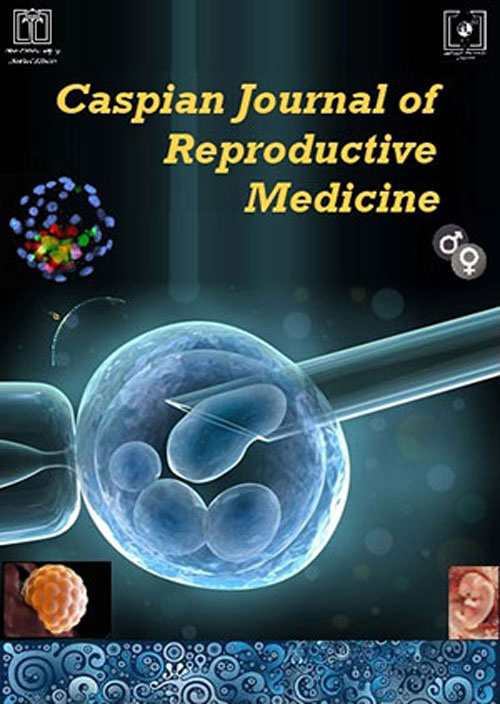فهرست مطالب

Caspian Journal of Reproductive Medicine
Volume:7 Issue: 2, Summer-Autumn 2021
- تاریخ انتشار: 1400/10/21
- تعداد عناوین: 4
-
Pages 1-6Background
Perimenopause is the time between changes in menstrual cycle toward menopause or permanent infertility. The aim of this study was to analyze the clinical, sonographic, and histological characteristics of perimenopausal women with abnormal uterine bleeding that was subsequently managed surgically.
MethodsThis retrospective study used existing data from 102 perimenopausal female with abnormal uterine bleeding, who underwent surgical procedure during one-year period of a tertiary care hospital in Kashmir, India from Jan 2018 to April 2019. Standard sagittal views of the uterus were used to measure the endometrial thickness using transvaginal sonography (TVS). Dilatation and Curettage (D&C) was performed for obtaining endometrial tissue for pathological evaluation.
ResultsThe most common complaint was menorrhagia with a mean duration of 12 months. The maximum endometrial thickness was seen with patients who finally had a diagnosis of endometrial hyperplasia with atypia and polyps. Patients with normal endometrium on pathology and those with chronic endometritis had similar endometrial thickness on TVS. Endometrial thickness was correlated with the severity of the lesion with an average thickness of 3 mm in atrophy, 10-12 mm in hyperplasia, and 18 mm in carcinoma.
ConclusionEndometrial hyperplasia needs active and vigilant surveillance for its diagnosis and management. In perimenopausal women, the endometrial thickness is fickle and may not reflect the development of atypia.
Keywords: Atypical endometrial hyperplasia, Endometrial neoplasms, Endometrial Hyperplasia, Hyperplasia, Perimenopause -
Pages 7-14Background
The burden of anemia in pregnancy (AIP) is significantly higher in developing countries, most especially in rural areas. This study was carried out to evaluate the effect of pregnant women’s knowledge and practices on the prevention of AIP in South-West Nigeria.
MethodsThis cross-sectional-based study involved 138 consenting pregnant women aged 18 - 42 years who had no complications (maternal and fetal) during pregnancy. Pretested interviewer-administered questionnaire consisting of three parts was used to collect data. The first part obtained information on the socio-demographic characteristics of the respondents. The second part assessed their knowledge on adequate diet and prevention of AIP, while the third part assessed the practices of respondents on the prevention of AIP. A binary logistic regression model was used to identify factors associated with anemia.
ResultsAbout 18.8% of respondents had poor knowledge, while 8.0% had a high score. Although all respondents claimed regular clinic attendance, 55.8% of them took their routine antenatal care (ANC). Pica practices were found in 7.2%. None of the respondents smoked, while 5.8% drank alcohol. None had food taboo. There was a significant association between the knowledge score and educational status (p = 0.006).
ConclusionThe findings indicated that the majority of pregnant women in rural communities in South-West Nigeria had moderate knowledge and good practices regarding the prevention of anemia.
Keywords: Anemia, Health Knowledge, Attitudes, Practice, Pregnant woman -
Pages 15-22Background
Prevention and control of coronavirus diseases (COVID-19) in pregnant women has become a major concern. The study was conducted to explain the Iranian pregnant women's experiences during the COVID-19 pandemic.
MethodsThis qualitative study was conducted with conventional content analysis. The pregnant women were selected through purposive sampling from six urban health centers until data saturation. Semi structured interviews were conducted through telephone with the interview guide. Systematic thematic analysis was used to identify and organize themes into clusters and categories across interviews.
ResultsTwelve pregnant women were recruited. Three theme categories were extracted from data analysis; "unpleasant feelings during pregnancy", "adjusted lifestyle" and “safe pregnancy care”. The pregnant women, while paying attention to the importance of pregnancy care, were forced to limit, delay or modify some cares in order to be safe.
ConclusionThe pregnant women experienced unpleasant feelings in this crisis; therefore, they should receive the necessary consultation to maintain mental health. The pregnant women reported some changes in their lifestyles and pregnancy care in order to prevent the disease. Regular training for all pregnant women is necessary to manage pregnancy period while maintaining the maternal and fetal health in crisis.
Keywords: COVID-19, Pregnant women, Feeling, Prenatal care, Qualitative research -
Pages 23-28Background
Pregnant women have supposedly been among the most vulnerable groups since the onset of COVID-19 crisis. Some of the complications of COVID-19 are expected to be more severe in pregnant women, which could be attributed to physiological changes occurring during pregnancy. The aim of this study was to determine the clinical as well as laboratory characteristics of pregnant women with COVID-19 infection.
MethodsIn this retrospective study, the medical records of all pregnant women with COVID-19, who were admitted in a tertiary hospital in Iran over the period between March and November 2020, were meticulously reviewed. The clinical and laboratory characteristics of 42 pregnant women with RT-PCR confirmed COVID-19 infection were assessed. Statistical analyses were performed on Stata 16.0. All statistical tests were two-tailed at the significance level of P < 0.05.
ResultsAt the time of the study, 42 pregnant women had the symptoms of COVID-19 and were hospitalized. The most common clinical signs of COVID-19 were: fever (69.0%), fatigue (31.0%), dyspnea (28.6%), and pharyngalgia (23.8%). In addition, the most common laboratory symptoms were: an increase in C-reactive protein (CRP) (69.0%), leukocytosis (66.7%), and lymphocytopenia (66.7%). Ground glass opacity (GGO) was a common (83.3%) finding in long computed tomography (CT scan).
ConclusionThe finding of this study indicated that most common clinical symptoms and laboratory parameters in pregnant women with COVID-19 were similar to those of non-pregnant women with COVID-19 infection as reported by other researchers.
Keywords: COVID-19, Pregnancy, laboratory test, pulmonary manifestations

